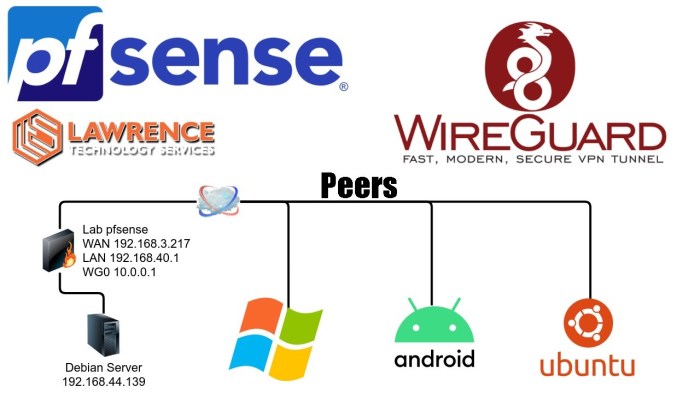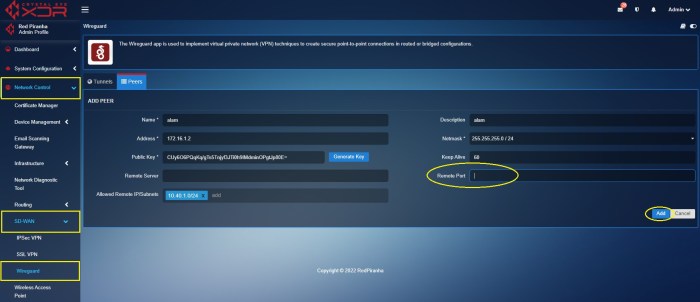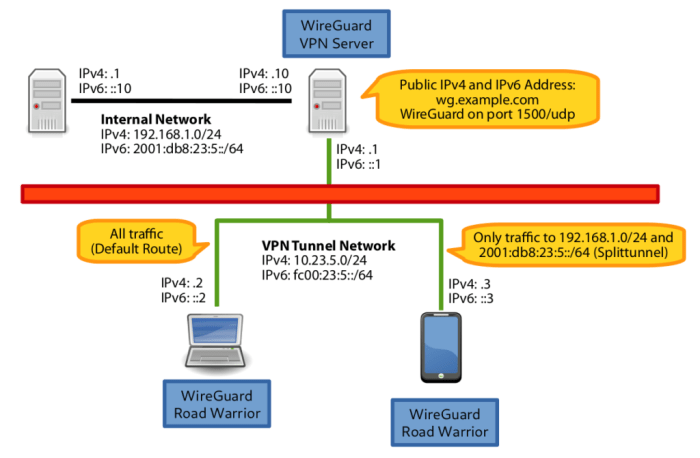In the realm of virtual private networks (VPNs), WireGuard stands out as a modern and secure solution. With its introduction of split tunneling, WireGuard offers a unique way to balance privacy and accessibility on Android devices. This comprehensive guide will delve into the intricacies of WireGuard split tunneling, empowering you to harness its capabilities and optimize your online experience.
WireGuard split tunneling allows you to selectively route traffic through the VPN tunnel while permitting other traffic to bypass it. This approach provides the flexibility to protect sensitive data on specific apps or websites while maintaining a direct connection for activities that benefit from lower latency or faster speeds.
Overview of WireGuard Split Tunneling for Android
WireGuard is a modern VPN protocol that offers a secure and efficient way to establish virtual private networks (VPNs). Split tunneling is a feature that allows you to selectively route specific traffic through the VPN tunnel while allowing other traffic to bypass the VPN and connect directly to the internet.
With WireGuard split tunneling on Android, you can choose which apps or types of traffic to send through the VPN and which to exclude. This can be useful for optimizing performance and reducing battery drain, as well as for accessing local network resources that may be blocked by the VPN.
Benefits of Split Tunneling with WireGuard on Android
- Improved performance: By excluding certain traffic from the VPN tunnel, you can reduce the amount of data that needs to be encrypted and decrypted, which can improve overall performance.
- Reduced battery drain: VPNs can be power-hungry, especially when encrypting and decrypting large amounts of data. Split tunneling can help to reduce battery drain by only encrypting the traffic that needs to be protected.
- Access to local network resources: Some VPNs can block access to local network resources, such as printers or shared drives. Split tunneling allows you to exclude specific apps or traffic from the VPN, so you can still access these resources while using the VPN.
Limitations of Split Tunneling with WireGuard on Android
- Security risks: Split tunneling can introduce security risks if you are not careful about which traffic you exclude from the VPN. For example, if you exclude all traffic from a specific app, that app will be able to access the internet without any protection from the VPN.
- Configuration complexity: Split tunneling can be more complex to configure than a traditional VPN connection. You will need to carefully consider which apps or types of traffic you want to exclude from the VPN, and you will need to configure your VPN client accordingly.
Configuring WireGuard Split Tunneling on Android

Configuring WireGuard split tunneling on Android devices involves creating a WireGuard interface and configuring specific applications to use it. Here’s a step-by-step guide:
Creating a WireGuard Interface
- Install the WireGuard app from the Google Play Store.
- Tap on the “+” icon in the bottom right corner.
- Select “Create New Tunnel.”
- Enter a name for the tunnel and tap on “Create.”
Configuring Split Tunneling
- Tap on the “Settings” icon in the top right corner.
- Enable the “Split Tunneling” option.
- Tap on the “Allowed Apps” tab.
- Select the applications you want to use the WireGuard connection.
Troubleshooting
*
-*Ensure that the WireGuard interface is active
Verify that the WireGuard icon in the status bar is green.
-
- -*Check firewall settings
Make sure that the WireGuard app is allowed to access the network.
- -*Check firewall settings
-*Update the WireGuard app
Keep the app up-to-date to resolve any potential issues.
Optimizing WireGuard Split Tunneling Performance
Fine-tuning the performance of WireGuard split tunneling on Android can significantly enhance speed and reliability. Here are some techniques to optimize performance:
Choosing the Appropriate MTU Size
The Maximum Transmission Unit (MTU) determines the maximum size of data packets that can be transmitted over the network. A larger MTU can improve performance by reducing packet fragmentation, but it can also lead to packet loss if the MTU is too large.
For most Android devices, an MTU of 1420 is recommended.
Enabling Compression
Enabling compression can reduce the size of data packets, improving performance on networks with limited bandwidth. WireGuard supports several compression algorithms, including zlib and lz4. Experiment with different algorithms to find the one that provides the best performance for your specific network conditions.
Adjusting Other Performance Settings
Additional performance settings can be adjusted to fine-tune WireGuard’s performance. These settings include:
- Cipher Algorithm: WireGuard supports several cipher algorithms, each with different performance characteristics. Choose a cipher algorithm that provides a good balance of speed and security.
- Key Exchange Algorithm: The key exchange algorithm determines how WireGuard establishes a secure connection. Choose a key exchange algorithm that is both secure and efficient.
- Handshake Timeout: The handshake timeout determines how long WireGuard will wait for a handshake to complete. A shorter handshake timeout can improve performance, but it can also lead to connection failures in unstable network conditions.
Troubleshooting WireGuard Split Tunneling Issues on Android
WireGuard split tunneling on Android can be a powerful tool, but it can also be prone to issues. This section will help you identify and resolve common problems that you may encounter.
The most common issue is connectivity problems. If you are having trouble connecting to the internet when WireGuard is enabled, there are a few things you can try:
- Make sure that your WireGuard configuration is correct. Double-check the IP addresses, ports, and keys that you have entered.
- Try disabling and then re-enabling WireGuard. This can sometimes fix connectivity issues.
- If you are using a firewall, make sure that it is configured to allow WireGuard traffic.
Another common issue is DNS leaks. This occurs when your DNS requests are not being routed through the VPN tunnel. To fix this, you can use a custom DNS server in your WireGuard configuration.
Finally, you may also experience slow speeds when using WireGuard. This can be caused by a number of factors, such as the quality of your internet connection, the number of devices that are connected to the VPN, and the encryption algorithm that you are using.
To improve speeds, you can try using a different encryption algorithm or connecting to a different server.
Comparison of WireGuard Split Tunneling with Other VPN Solutions on Android
WireGuard split tunneling offers several advantages over other VPN solutions for Android devices. It is more secure, performs better, and is easier to use.
Security
WireGuard is a highly secure VPN protocol that uses state-of-the-art cryptography. It is resistant to eavesdropping, man-in-the-middle attacks, and other security threats. Other VPN protocols, such as OpenVPN and IPSec, are also secure, but they are not as efficient as WireGuard.
Performance
WireGuard is a very efficient VPN protocol. It uses less CPU and memory than other VPN protocols, which results in better performance. This is especially important for mobile devices, which have limited resources.
Ease of Use
WireGuard is easy to set up and use. It has a simple configuration file that can be easily edited. Other VPN protocols, such as OpenVPN and IPSec, are more complex to set up and use.
The following table summarizes the key differences between WireGuard split tunneling and other VPN solutions for Android devices:
| Feature | WireGuard Split Tunneling | Other VPN Solutions |
|---|---|---|
| Security | Highly secure | Secure, but not as efficient as WireGuard |
| Performance | Very efficient | Less efficient than WireGuard |
| Ease of Use | Easy to set up and use | More complex to set up and use |
Advanced Techniques for Using WireGuard Split Tunneling on Android
Beyond the basics, there are several advanced techniques that can enhance the functionality and performance of WireGuard split tunneling on Android devices. These techniques include utilizing custom DNS servers, establishing multiple tunnels, and implementing firewall rules.
Custom DNS Servers
WireGuard split tunneling allows you to specify custom DNS servers for your VPN connection. This provides greater control over DNS resolution and can improve privacy and security by preventing DNS leaks.
Multiple Tunnels
In certain scenarios, it may be beneficial to set up multiple WireGuard tunnels on your Android device. This can be useful for accessing different networks or resources with different security requirements.
Firewall Rules
WireGuard split tunneling supports the implementation of firewall rules. This allows you to fine-tune network traffic and control which applications or IP addresses can access the VPN tunnel.
Security Considerations for WireGuard Split Tunneling on Android
WireGuard split tunneling on Android offers enhanced security and privacy by selectively routing only specific traffic through the VPN tunnel. However, it also introduces certain security considerations that need to be addressed.
Potential Vulnerabilities and Attack Vectors
Split tunneling can create potential vulnerabilities if not configured securely. One concern is the possibility of DNS leaks, where DNS requests are inadvertently sent outside the VPN tunnel, exposing the user’s real IP address. Additionally, split tunneling can be exploited by malicious apps or websites that attempt to bypass the VPN by sending traffic through non-tunneled connections.
Recommendations for Mitigating Risks
To mitigate these risks, it is crucial to configure WireGuard split tunneling carefully. Using a trusted VPN provider, keeping the VPN app up-to-date, and implementing strict firewall rules for non-tunneled traffic can help prevent unauthorized access. Additionally, DNS leak protection features can be enabled to ensure that all DNS requests are routed through the VPN tunnel.
Comparison to Other VPN Solutions
Compared to other VPN solutions, WireGuard split tunneling offers several security advantages. It utilizes a modern and secure cryptographic protocol, providing strong encryption and authentication. Moreover, its open-source nature allows for transparent security audits, enhancing trust and accountability.
Use Cases for WireGuard Split Tunneling on Android
WireGuard split tunneling on Android offers a unique approach to VPN connectivity, providing enhanced privacy, security, and productivity in various scenarios. Here are some key use cases:
Enhanced Privacy and Anonymity: Split tunneling allows users to route only specific apps or traffic through the VPN, while keeping other traffic on the local network. This provides a level of privacy and anonymity, as sensitive data or browsing activities are only protected within the VPN tunnel.
Accessing Geo-restricted Content
Split tunneling enables users to access geo-restricted content while maintaining local connectivity. For instance, a user can set up the VPN to only route traffic for streaming services through the VPN, while keeping other apps connected to the local network.
This allows them to enjoy streaming content from different regions without affecting their regular internet usage.
Improved Security for Sensitive Apps
Split tunneling provides an extra layer of security for sensitive apps, such as banking or messaging apps. By routing only those apps through the VPN, users can ensure that sensitive data and communications are protected from potential threats on the local network.
Optimizing Network Performance
Split tunneling can optimize network performance by reducing the load on the VPN connection. By routing only essential traffic through the VPN, users can avoid unnecessary bandwidth consumption and latency issues, while still maintaining the privacy and security benefits of the VPN.
Balancing Privacy and Convenience
Split tunneling offers a balance between privacy and convenience. Users can choose to route only specific apps or traffic through the VPN, while keeping other apps connected to the local network. This allows them to maintain access to local resources and services while still protecting sensitive data and activities.
Future Developments in WireGuard Split Tunneling for Android
The future of WireGuard split tunneling for Android holds exciting prospects. Developers are actively working on enhancing performance, adding new features, and improving security.
Performance Enhancements
Future versions of WireGuard for Android will likely include optimizations to improve performance, particularly for devices with limited resources. This could involve optimizing network traffic handling, reducing memory usage, and improving CPU efficiency.
New Features
Several new features are in the pipeline for WireGuard split tunneling on Android. These include:
-
- -*Support for multiple VPN profiles
Users will be able to create and manage multiple VPN profiles, each with its own set of rules and configurations.
- -*Support for multiple VPN profiles
-*Advanced rule management
More granular control over which apps and traffic are routed through the VPN tunnel.
-*Custom DNS settings
The ability to specify custom DNS servers for the VPN connection.
Security Updates
WireGuard developers are committed to maintaining the security of the platform. Future updates will include regular security patches and enhancements to protect against vulnerabilities and exploits.
Roadmap and Future Direction
The future roadmap for WireGuard split tunneling on Android includes:
- Continuous performance optimizations
- Expansion of supported features
- Integration with other Android features, such as system-wide VPN settings
- Collaboration with the Android community to improve the overall VPN experience
These developments promise to make WireGuard split tunneling even more powerful and versatile for Android users, providing enhanced security, flexibility, and performance.
Resources for Learning More about WireGuard Split Tunneling on Android

To delve deeper into the intricacies of WireGuard split tunneling on Android, we recommend exploring the following resources:
Tutorials
- WireGuard Official Documentation: Comprehensive guides and tutorials provided by the WireGuard team.
- WireGuard Android Wiki: A repository of user-contributed tutorials, FAQs, and troubleshooting tips.
- XDA Developers Guide: A step-by-step guide to setting up WireGuard split tunneling on Android.
Documentation
- WireGuard Protocol Specification: Detailed technical documentation of the WireGuard protocol.
- Android VPN Framework Documentation: Official Android documentation on VPN implementation.
- Android WireGuard VPN Guide: Specific documentation for WireGuard VPN on Android.
Community Forums
- WireGuard Community Forum: A dedicated forum for WireGuard users to ask questions, share experiences, and collaborate.
- WireGuard Subreddit: A popular discussion forum for WireGuard-related topics.
- WireGuard Android Gitter Channel: A real-time chat channel for WireGuard Android developers and users.
Other Resources
- Netgate Blog: WireGuard Split Tunneling on Android: An informative article explaining the benefits and implementation of WireGuard split tunneling on Android.
- IVPN Guide: WireGuard Split Tunneling: A beginner-friendly guide to WireGuard split tunneling, including a section on Android configuration.
- WireGuard Android Issue Tracker: A repository for reporting bugs and suggesting improvements for the WireGuard Android app.
Summary

WireGuard split tunneling on Android unlocks a world of possibilities, enhancing privacy, security, and productivity. Whether you’re a privacy-conscious individual, a security professional, or simply seeking a more tailored VPN experience, this guide has equipped you with the knowledge and techniques to harness the full potential of WireGuard split tunneling.
As the technology continues to evolve, stay tuned for future developments and advancements that will further enhance your online experience.